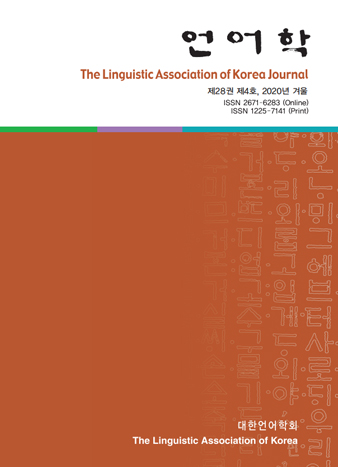대한언어학회 전자저널

28권 4호 (2020년 12월)
- 제주 한국어에서의 반복 부사어 모음 변이 연구
-
강석한
Pages : 1-28
Abstract
Kang, Seokhan. (2020). A study of vowel variations in the adverb reduplication of Jeju Korean. The Linguistic Association of Korea Journal, 28(4), 1-28. In the emphatic reduplication of Jeju Korean which implies emphatic meanings, a vowel change takes place as a form of total reduplication. It is argued that vowel variations in the reduplication occur through both changes in vowel quantity and quality, using the extended duration of nuclear syllables and wider formant differences between F1 and F2. To provide the morphological evidence, 512 reduplicative adverbs have been checked and then divided into two forms: basic and emphatic. The forms are classified into two groups depending on the direction of vowel change: height and frontness. To demonstrate the direction of the phonological change, speech experiments have been carried out for ten native speakers of Jeju Korean over 60 years old. The analysis focuses on the principal features of acoustic/phonetic signals, namely, the fundamental frequency (Hz), intensity (dB), formant structure of F1 and F2, the duration of vowels, and the syllable nucleus. Out of six acoustic cues, formant structure (F1 and F2) and duration of the syllable-nucleus show statistical differences between the basic and emphatic reduplicants. The results imply that adverb reduplication, in the case of Jeju Korean, uses the perceptual effects through mora extension for acoustic quantity and rhythmic realization for vowel quality.
Keywords
# 반복 부사어(adverbial reduplication) # 모음 변이(vowel variation) # 제주 한국어(Jeju Korean) # 모라(mora) # 모음 자질(vowel quality) # 신호 양(cue quantity)
References
- 강공택. (1986). 제주 방언의 반복 부사 구조 연구. 제주대학교 석사학위논문.
- 강석한. (2008). 제주 한국어의 강조 중첩어에 나타난 자음 음변화 양상 연구. 언어학 연구, 13, 1-16.
- 강석한. (2010). 제주 한국어의 반복 부사어 변이형 형성에서의 발화와 인지 요소 연구. 영주어문, 20, 5-26.
- 강석한. (2018). 제주 한국어 음상 강화형 반복 부사어 연구. 언어학, 26(3), 89-116.
- 김영돈. (1965). 제주도 민요연구 (상). 서울: 일조각.
- 김원보. (2005). 제주방언 모음의 음향분석. 언어학 연구, 10(2), 161-174.
- 박동규. (2000). 어두 자, 모음 대립형 반복 복합어의 형성에 관한 고찰. 인문 과학연구, 5, 75-95.
- 박용후. (1988). 제주방언 연구 (자료편). 고려대학교 민족문화연구소.
- 성철재. (2005). 충남지역 대학생들의 한국어 단모음 포먼트 분석. 언어학, 43, 189-213.
- 송상조. (2007). 제주말 큰 사전. 서울: 한국문화사.
- 손달임. (2012). 현대국어 의성의태어의 형태와 음운 연구. 이화여자대학교 박사학위논문.
- 송정근. (2010). 중첩의 두 유형. 한국어 의미학, 33, 131-152.
- 신우봉. (2015). 제주 방언 단모음과 어두 장애음의 음향 음성학적 연구. 고려대학교 박사학위논문.
- 여상필. (1998). 절단 차용어의 최소 요건. 신영어영문학, 10, 233-251.
- 오정란. (1993). 국어\'ㄹ\'음의 양음절성과 겹자음화. 언어, 18(1), 19-46.
- 임규홍. (2015). 국어 모음의 음상과 의미의 유연성. 언어과학연구, 74, 189-216.
- 이문규. (1996). 음운교체와 상징어의 어감 분화. 어문학, 57, 173-198.
- 이숭녕. (1978). 국어 음성 상징론에 대하여. 언어, 3(2), 1-19.
- 이영희. (1982). 제주도 방언의 상징 연구. 제주대학교 석사학위논문.
- 이익섭. (1965). 국어 복합명사의 IC 분석. 국어국문학, 30, 121-129.
- 이희승. (1955). 국어학개설. 서울: 민중서관 26
- 정승철. (1998). 제주방언의 특징에 대하여. 새국어생활, 8(4), 133-152.
- 정철주. (2015). 의사(疑似) 반복 합성어의 유형과 형성. 인문과학연구, 26, 69-96.
- 제주특별자치도. (2009). 제주어사전. 제주: 일신옵셋인쇄사.
- 채완. (1986). 국어 어순의 연구 (국어학 총서 10). 서울: 태학사.
- 허웅. (1982). (개고신판) 국어음운학 . 서울: 정음사.
- 현평효. (1985). 제주도 방언 연구. 서울: 이우출판사.
- Assman, W. F., & Kartz, W. F. (2000). Time-varying spectral change in the vowels of children and adults. Journal of the Acoustical Society of America, 102, 28-40.
- Flemming, E. (2005). Speech perception and phonological contrast. In D. Pisoni & R. Remez (Eds.), The handbook of speech perception (pp. 156-181). Cambridge: Blackwell.
- Inkelas, S., & Zoll, C. (2005). Reduplication: Doubling in morphology(Cambridge Studies in Linguistics 106). Cambridge: Cambridge University Press.
- Kang, S.-H. (2008). Non-morphological motivation in Cheju Korean emphatic reduplication. Paper presented at the 16th ICKL, Cornell University, 3-5 August.
- Kang, S.-H. (2013). The phonetics and phonology of emphatic reduplication: A case study of Jeju Korean. A Study of Phonetics, Phonology, and Morphology, 19(1), 3-32.
- Kawahara, H., Katayose, H., Cheveigné, A. D., & Patterson, R. D. (1999). Fixed point analysis of frequency to instantaneous frequency mapping for accurate estimation of F0 and periodicity. Retrieved August 15, 2019, from https://www.isca-speech.org/archive/eurospeech_1999.
- Kent, R. D., & Read, C. (2006). The acoustic analysis of speech. San Diego: Singular Publishing Group.
- Liénard, J. S., & Di Benedetto, M. G. (1999). Effect of vocal effort on spectral properties of vowels. The Journal of the Acoustical Society of America, 106(1), 411-422.
- McCarthy, J., & Prince, E. (1995). Faithfulness and reduplicative identity. Cambridge: Cambridge University Press.
- Martin, S. E. (1962). Phonetic symbolism in Korean. American Studies in Altaic Linguistics, 13, 177-189.
- Niebuhr, O., Jarzabkowska, P., Lorenz, U., Schulz, C., & Sodigov, F. (2012). Say it again, Sam! The prosodic profiles of emphatic reduplication in German. Retrieved August 12, 2019, from http://www.isca-speech.org/archive/sp2012.
- Onn, F. M. (1980). Aspects of Malay phonology and morphology: A generative approach. Bangi: Universiti Kebangsaan Malaysia.
- Segalowitz, N. (2010). Cognitive bases of second language fluency. New York: Routledge.
- Yang, B. (1996). A comparative study of American English and Korean vowels produced by male and female speakers. Journal of Phonetics, 24, 245-261.